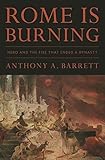Rome Is Burning : Nero and the Fire That Ended a Dynasty / Anthony A. Barrett.
Material type: TextSeries: Turning Points in Ancient History ; 9Publisher: Princeton, NJ : Princeton University Press, [2020]Copyright date: ©2020Description: 1 online resource (368 p.) : 51 b/w illus. 1 table. 1 mapContent type:
TextSeries: Turning Points in Ancient History ; 9Publisher: Princeton, NJ : Princeton University Press, [2020]Copyright date: ©2020Description: 1 online resource (368 p.) : 51 b/w illus. 1 table. 1 mapContent type: - 9780691208503
- Great Fire, Rome, Italy, 64
- Nero, Emperor of Rome, 37-68
- Rome-History-Nero, 54-68
- HISTORY / Ancient / Rome
- Aventine
- Christians
- Circus Maximus
- Dio
- Golden House
- Great London Fire
- New Rome
- Palatine
- Pilate
- Roman
- Suetonius
- Tacitus
- ancient fires
- architecture
- arson
- coliseum
- conspiracy
- crucifixions
- economy
- empire
- fiddling while Rome burns
- history of fire
- lake
- persecution
- procurator
- urban fires
- 937.6307 23
- DG285.3 .B37 2020
- online - DeGruyter
| Item type | Current library | Call number | URL | Status | Notes | Barcode | |
|---|---|---|---|---|---|---|---|
 eBook
eBook
|
Biblioteca "Angelicum" Pont. Univ. S.Tommaso d'Aquino Nuvola online | online - DeGruyter (Browse shelf(Opens below)) | Online access | Not for loan (Accesso limitato) | Accesso per gli utenti autorizzati / Access for authorized users | (dgr)9780691208503 |
Browsing Biblioteca "Angelicum" Pont. Univ. S.Tommaso d'Aquino shelves, Shelving location: Nuvola online Close shelf browser (Hides shelf browser)

|

|

|

|

|

|

|
||
| online - DeGruyter An Infinite History : The Story of a Family in France over Three Centuries / | online - DeGruyter Dear Ms. Schubert : Poems by Ewa Lipska / | online - DeGruyter How to Be Content : An Ancient Poet's Guide for an Age of Excess / | online - DeGruyter Rome Is Burning : Nero and the Fire That Ended a Dynasty / | online - DeGruyter Foundations : How the Built Environment Made Twentieth-Century Britain / | online - DeGruyter Unhealthy Politics : The Battle over Evidence-Based Medicine / | online - DeGruyter Dreamworlds of Race : Empire and the Utopian Destiny of Anglo-America / |
Frontmatter -- CONTENTS -- List of Illustrations -- Series Editor’s Foreword -- Acknowledgments -- Timeline -- Prologue -- I Introduction -- THE FIRE -- II Fires in Ancient Rome -- III The Great Fire -- IV Responsibility -- THE AFTERMATH -- V The Christians and the Great Fire -- VI The New Rome -- VII The Significance of the Great Fire -- Epilogue. The Great Fire as an Enduring Cultural Phenomenon -- Principal Sources: Tacitus, Suetonius, and Dio -- Notes -- Glossary -- Bibliography -- Index
restricted access online access with authorization star
http://purl.org/coar/access_right/c_16ec
Drawing on new archaeological evidence, an authoritative history of Rome’s Great Fire—and how it inflicted lasting harm on the Roman EmpireAccording to legend, the Roman emperor Nero set fire to his majestic imperial capital on the night of July 19, 64 AD and fiddled while the city burned. It’s a story that has been told for more than two millennia—and it’s likely that almost none of it is true. In Rome Is Burning, distinguished Roman historian Anthony Barrett sets the record straight, providing a comprehensive and authoritative account of the Great Fire of Rome, its immediate aftermath, and its damaging longterm consequences for the Roman world. Drawing on remarkable new archaeological discoveries and sifting through all the literary evidence, he tells what is known about what actually happened—and argues that the disaster was a turning point in Roman history, one that ultimately led to the fall of Nero and the end of the dynasty that began with Julius Caesar.Rome Is Burning tells how the fire destroyed much of the city and threw the population into panic. It describes how it also destroyed Nero’s golden image and provoked a financial crisis and currency devaluation that made a permanent impact on the Roman economy. Most importantly, the book surveys, and includes many photographs of, recent archaeological evidence that shows visible traces of the fire’s destruction. Finally, the book describes the fire’s continuing afterlife in literature, opera, ballet, and film.A richly detailed and scrupulously factual narrative of an event that has always been shrouded in myth, Rome Is Burning promises to become the standard account of the Great Fire of Rome for our time.
Mode of access: Internet via World Wide Web.
In English.
Description based on online resource; title from PDF title page (publisher's Web site, viewed 27. Jan 2023)


